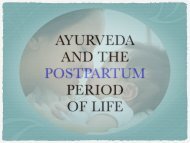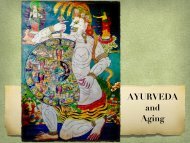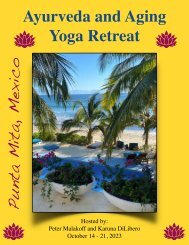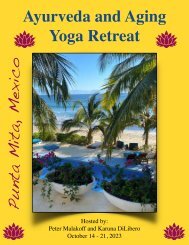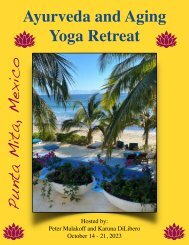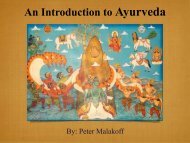Ayurveda and Aging 10.1
You also want an ePaper? Increase the reach of your titles
YUMPU automatically turns print PDFs into web optimized ePapers that Google loves.
AYURVEDA <br />
<strong>and</strong> <br />
<strong>Aging</strong>
In 2004, I received a degree in <strong>Ayurveda</strong> from<br />
Kalidas Sanskrit University in India. <br />
The very first instruction I received in the<br />
formal welcome to the school was:<br />
‘Everything in the world is medicinal, <strong>and</strong><br />
everything in the world is poisonous.<br />
‘<strong>Ayurveda</strong> will teach you how to tell the<br />
DIFFERENCE between the two.’
In this presentation, we will<br />
explore these various <br />
‘Differences’
After graduation, I visited Benaras, the oldest<br />
still-living city in the world. There, I heard a story<br />
about Kabir, one of the greatest saints of medieval<br />
India. It went like this: <br />
The king of Benares had built a large palace on<br />
the banks of the Ganges river <strong>and</strong> wanted Kabir<br />
to come <strong>and</strong> visit his palace. Kabir accepted, <strong>and</strong><br />
after a tour of the palace, the King asked him<br />
what he thought of the place.
Kabir replied,<br />
‘There are two defects which cannot be fixed,’ <br />
‘Tell me what they are, <strong>and</strong> I shall fix them right away,’ said<br />
the King.<br />
‘You cannot do it,’ replied Kabir. <br />
‘Why not? I have the money <strong>and</strong> men. Tell me what they<br />
are <strong>and</strong> I shall have them fixed,’ said the king<br />
Kabir then said:<br />
‘One is that this palace will grow old <strong>and</strong> decay. <br />
The second is that you will grow old <strong>and</strong> die.’
Our consideration is suggested by <br />
Kabir’s -‘Grow old <strong>and</strong> die’: <br />
This brings us to<br />
AYURVEDA <strong>and</strong> <strong>Aging</strong><br />
So let’s begin with a consideration of<br />
AYURVEDA
<strong>Ayurveda</strong> is the <br />
‘Veda’ ‘(Science)<br />
of <br />
‘Ayu’ (Life)
<strong>Ayurveda</strong> <br />
is taught on<br />
earth so<br />
mankind can<br />
enjoy a long<br />
<strong>and</strong> healthy<br />
lifespan
<strong>Ayurveda</strong> contains <br />
the Vidya or knowledge <br />
of ‘how to create or maintain <br />
the health of the healthy <br />
<strong>and</strong> cure or palliate the disease <br />
of a diseased person’
From the Yoga Sutras, <br />
<strong>Ayurveda</strong> draws a fundamental<br />
principle regarding the Law of Karma:<br />
‘Heyam Dukham Anagatam’<br />
- Patanjali Yoga Sutras 2:16<br />
‘The suffering that has not yet come <br />
can be avoided’
The suffering <br />
that is here, <br />
is here because of ‘karmic’<br />
reasons . . .<br />
it has past cause or causes<br />
<strong>and</strong> must be endured
But, the suffering <br />
that is not yet here can be avoided, <br />
by changing our actions<br />
<strong>Ayurveda</strong> says:<br />
with proper underst<strong>and</strong>ing <br />
we may move towards health <br />
by means of right actions
There is a causative factor for the<br />
manifestation of a bodily being, but<br />
there is <br />
no cause for the cessation of <br />
this manifestation since death<br />
following birth is the natural flow of<br />
life itself<br />
- Charaka Samhita
Suffering born of Time (<strong>Aging</strong>) is<br />
inherent in life <strong>and</strong> cannot be<br />
avoided, but only palliated. <br />
This is a foundational principle<br />
of <br />
<strong>Ayurveda</strong> <strong>and</strong> <strong>Aging</strong>
KALA<br />
(Time)
Life is held in the h<strong>and</strong>s <br />
of <br />
Time or Kala<br />
<strong>and</strong> Time is a fundamental<br />
consideration <br />
when we consider: <br />
<strong>Aging</strong>
In <strong>Ayurveda</strong>,<br />
Old Age <strong>and</strong> <strong>Aging</strong> is a<br />
‘disease’ brought about by<br />
Time
It is written in the Ayurvedic<br />
texts:<br />
‘Shiryate Iti Shariram’<br />
‘The body is constantly<br />
decaying’
We know everyone <br />
who has taken birth <br />
must grow old <strong>and</strong> die, <br />
but no one wants to grow old<br />
<strong>and</strong> no one wants to die.<br />
But even from conception the<br />
body is tending towards death
According to Buddha:<br />
Birth, Disease, Old Age, <strong>and</strong><br />
Death comprise the inevitable<br />
suffering <br />
of a human being
“. . . birth is suffering, Old Age is<br />
suffering, illness is suffering, union<br />
with unpleasant things is suffering,<br />
separation from pleasant things is<br />
suffering, not obtaining what we wish<br />
is suffering; all clinging to existence is<br />
suffering”<br />
- Buddha
Buddha was asked, <br />
‘How are you different than other<br />
men?’<br />
He replied:<br />
‘I was disturbed by<br />
Birth, Disease, Old Age <strong>and</strong> Death,<br />
others did not seem to be so disturbed’
In <strong>Ayurveda</strong>, <br />
any state that is not pleasurable <br />
is called - ‘Disease’<br />
<br />
In Tibetan medicine, <br />
(which arose from <strong>Ayurveda</strong>), <br />
life itself is a disease that ends in death
<strong>Ayurveda</strong> considers <strong>Aging</strong><br />
Born of time <br />
as <br />
a ‘Natural’, <strong>and</strong> <br />
only Palliatible <br />
disease
‘Palliative’ here refers to:<br />
Treatment that affirms life <strong>and</strong><br />
regards ‘<strong>Aging</strong>,’ <strong>and</strong> death as a<br />
natural <strong>and</strong> normal process<br />
Palliative Care provides relief<br />
from unnecessary pain or<br />
distressing symptoms
Even though Buddha said:<br />
‘Suffering is inevitable’<br />
he also said that:<br />
‘All suffering is not necessary’
The ‘disease’ of <strong>Aging</strong> is<br />
inevitable, <br />
But, it may be manifested in a<br />
timely or untimely,<br />
comfortable or uncomfortable,<br />
disease-free or disease-filled,<br />
manner
The Ayurvedic approach to <strong>Aging</strong>: <br />
is to remedy <strong>and</strong>/or palliate <br />
the <br />
underlying imbalances <br />
brought about by <strong>Aging</strong>
Even though,<br />
Time or Kala creates an<br />
unavoidable imbalances in the<br />
body<br />
<strong>Ayurveda</strong> teaches us how to<br />
palliate those ‘unavoidable’<br />
imbalances
According to <strong>Ayurveda</strong>-<br />
The growth, development,<br />
maintenance <strong>and</strong> decay <br />
of the body <br />
are dependent on <br />
four factors or qualities:
1) Kala (time)<br />
2) Swabhava <br />
(nature, doshic make up)<br />
3) Ahar (Diet)<br />
4) Paryavarana -Environmental<br />
factors
The first two: <br />
1) Kala (Time)<br />
2) Swabhava <br />
(nature, doshic make up)<br />
We Cannot Control <br />
but only Palliate
The second two:<br />
3) Ahar (Diet)<br />
4) Environmental factors<br />
We Can Control
Diet (Ahar) <strong>and</strong> Environment) <br />
can be controlled<br />
AYURVEDA PROVIDES THE<br />
WISDOM OF HOW TO DO SO<br />
according to:<br />
Kala - Time (impersonal) <br />
<strong>and</strong> Svabhava- Self Nature (personal)
LET’S <br />
LOOK AT EACH OF THESE FOUR FACTORS <br />
STARTING WITH TIME
Kala or Time holds <br />
a human being <br />
in its grasp <br />
from birth until death
So fundamental is Kala or<br />
time that an image of Kala<br />
holding the wheel of life is<br />
painted directly next to the<br />
main entry of every Tibetan<br />
Buddhist monastery
Greed<br />
Anger<br />
Ignorance<br />
Delusion<br />
The ‘Three Poisons’ of life
It is called:<br />
the ‘Bhavachakra’ <br />
or the <br />
The Wheel of Becoming<br />
or<br />
The Wheel of Life
It is Kala or Time that creates:<br />
• The Yugas<br />
• The seasons of a year<br />
• The hours of day <strong>and</strong> night<br />
• The seasons of a person’s life<br />
• <strong>Aging</strong>
Buddha spoke of Time <br />
as the context, <br />
of inescapable suffering <br />
. . . for it is Time that<br />
determines our inability to gain<br />
any permanent happiness in<br />
life, <br />
no matter what our actions are
Just as we need to underst<strong>and</strong> the<br />
place where we live<br />
the season of the year<br />
<strong>and</strong> the time of the day<br />
<strong>Ayurveda</strong> says it is necessary to<br />
underst<strong>and</strong> <br />
\<br />
the Season or Time <br />
of our life
The effect of Time on the body<br />
is Kshaya or the diminishing of<br />
all the capabilities of the bodymind<br />
with Old Age
Let’s look more closely <br />
at how Kala or Time<br />
is expressed <br />
in the ‘Stages of Life’
The Stages of Life
The Ch<strong>and</strong>ogya Upanishad says<br />
that a man or woman enjoys 116<br />
years of life<br />
Balavastya: +/- 24 years<br />
Yuvavastha: +/- 44yrs (24-68)<br />
Vrddhavastha: +/- 48 yrs (108-116)
Balavastya (Youth)<br />
From conception to a girl’s first period<br />
(approximately 14-16 years of age; now<br />
earlier) is the time that Kapha or the<br />
EARTH <strong>and</strong> WATER elements rules.<br />
This period exhibits a steady increase<br />
<strong>and</strong> coordination of the strength <strong>and</strong><br />
integrity of the body, mind <strong>and</strong> senses
Madhyavasta (Middle Age)<br />
The FIRE element rule middle age <strong>and</strong><br />
lasts (approximately) from 14-16 years to<br />
60-70 years of age. It is dominated by<br />
PITTA DOSHA. There is an increase of<br />
hormonal activity, the digestive abilities<br />
of food <strong>and</strong> experience; full engagement<br />
of the senses, mind, intellect <strong>and</strong> a<br />
greater (or lesser) mastery of will
Vriddhavastha (Old Age)<br />
This is the period from 70 years to<br />
our death, when there is everincreasing<br />
wasting or decay<br />
(Kshaya) in the body. This time of<br />
life correlates <br />
with Vata Dosha or the Air <strong>and</strong><br />
Ether elements
As we age there is a natural decrease<br />
of the Dhatus or bodily tissues:<br />
There is wrinkling of the skin, graying<br />
of the hair, baldness, diminished<br />
ability to do physical work, diminished<br />
digestive power (JatharAgni) <strong>and</strong><br />
diminished immunity (Ojas)
In Old Age <br />
(even if one is not sick or in pain)<br />
there is a decrease in the <br />
(sensory organs) <br />
There is diminishing strength,<br />
speech, mental <strong>and</strong> cognitive<br />
functions, memory, intellect <strong>and</strong><br />
analytic ability
When these symptoms come<br />
about in accord with a<br />
balanced or healthy <br />
Swabhava (self-nature), <br />
it is known as <br />
Natural <strong>Aging</strong>
When <strong>Aging</strong> results from a result<br />
of a defective diet <strong>and</strong> lifestyle,<br />
Vriddhavastha (Old Age) begins<br />
earlier <strong>and</strong> is then known as<br />
Akalaja Vriddhavastha<br />
or (untimely <strong>Aging</strong>) <strong>and</strong> is usually<br />
accompanied by disease
Worry, Anxiety, Smoking increase<br />
<strong>Aging</strong> in any individual
<strong>Aging</strong> can be slowed <strong>and</strong><br />
‘Untimely <strong>Aging</strong>’ is preventable. <br />
Even if symptoms of untimely<br />
<strong>Aging</strong> are already manifested,<br />
they can be managed or<br />
palliated by applying the<br />
principles of <strong>Ayurveda</strong>
One of the well-known principles of<br />
<strong>Ayurveda</strong> is:<br />
‘Like increases Like<br />
Opposites decrease one another’ <br />
The words for ‘Health’ in <strong>Ayurveda</strong><br />
is Svastha, Sama or balance. Balance<br />
is the working principle of <strong>Ayurveda</strong>
According to <strong>Ayurveda</strong>, the<br />
‘patho’-physiology of <strong>Aging</strong> is<br />
caused primarily by diet <strong>and</strong> the<br />
process of <strong>Aging</strong> can be slowed<br />
down by correcting <strong>and</strong><br />
balancing <br />
the diet <strong>and</strong> lifestyle
SVABHAVA<br />
or<br />
Self nature
So, the first factor is TIME-KALA<br />
The second of the four factors,<br />
(Kala, Svabhava, Diet,<br />
Environment)<br />
that creates the growth, development,<br />
maintenance <strong>and</strong> decay of the body<br />
is‘Svabhava’ <br />
- the unique, individual nature, or<br />
elemental makeup of our body
For most people in the West today<br />
who have gained a little knowledge of<br />
<strong>Ayurveda</strong>, this elemental makeup of<br />
the body is called -<br />
‘Svabhava,’<br />
which is another name for <br />
Dosha
To balance Svabhava it is<br />
necessary to underst<strong>and</strong> the <br />
‘5 elements,’ as each of our<br />
bodies is composed of<br />
differing combinations of<br />
what are called the <br />
5 elements or the <br />
Panchamahabhutas
We must underst<strong>and</strong> <strong>and</strong> determine<br />
our Dosha <br />
so we can balance it<br />
When we underst<strong>and</strong> our environment<br />
in terms of the five elements, we can<br />
begin to underst<strong>and</strong> its Doshic Effect
These five elements are:<br />
Ether (Akash)<br />
Air (Vayu)<br />
Fire (Agni or Tejas)<br />
Water ( Jala)<br />
Earth (Bhumi)
The Five Elements<br />
Panchamahabhutas
Everything in creation is made<br />
of <br />
differing combinations of <br />
the 5 elements <br />
(always <strong>and</strong> only <br />
all-together appearing)<br />
They are called the <br />
Panchamahabhutas
When the <br />
Panchamahabhutas are<br />
considered in terms of location<br />
they are called: the Environment:<br />
desert, ocean, forest, mountain,<br />
cold, hot, windy, dry
When the <br />
Panchamahabhutas are<br />
considered in terms of Food<br />
they are called- The Six tastes:<br />
sweet, sour, salty, bitter,<br />
pungent, astringent
When the <br />
Panchamahabhutas are<br />
considered in terms of the<br />
Seasons of the year, they are<br />
called: <br />
spring, summer, fall, winter
When the <br />
Panchamahabhutas are<br />
considered in terms of the<br />
Time of the day, they are<br />
called: dawn, morning,<br />
afternoon, evening <strong>and</strong><br />
nighttime
When the <br />
Panchamahabhutas are<br />
considered in terms of the<br />
Seasons of a persons life, they<br />
are called: childhood,<br />
adolescence, middle age <strong>and</strong><br />
Old Age
When the <br />
Panchamahabhutas are<br />
considered in terms of the<br />
Ages of the Universe they are<br />
called the Yugas:<br />
Kali, Dwarpa, Treta <strong>and</strong> Sat
When the Panchamahabhutas<br />
are considered in terms of the<br />
human body they are called:<br />
Doshas
When <strong>Ayurveda</strong> traveled to the<br />
West through Persia <strong>and</strong> then<br />
Greece, these Doshas were<br />
called the Humors
Hippocrates
Galen
Doshas<br />
Panchamahabhutas<br />
<strong>and</strong><br />
Dosha
“Neither in theory nor in fact is<br />
there a physical manifestation<br />
that cannot be accounted for<br />
by the concept of Tridosha”<br />
– Charaka Samhita
The ‘Nature’ or quality <br />
of a thing<br />
(or one’s body) <br />
is called: <br />
DOSHA <br />
or <br />
SVABHAVA
When we consider <br />
an individual being <br />
<strong>and</strong> his or her unique combination <br />
of the elements<br />
the particular element (or<br />
elements) <br />
that predominates amongst them <br />
is called their Dosha
DOSHA <br />
(Also) Means ‘that which vitiates,<br />
aggravates, darkens, spoils <br />
or <br />
causes things to decay’
There are<br />
Varying combinations of the<br />
Panchamahabhutas or <br />
5 Elements that determine the<br />
Dosha
Vata, Pita <strong>and</strong> Kapha <br />
are the 3 Doshas
Let’s look at some examples of<br />
Dosha <strong>and</strong> how differing<br />
combinations of the elements<br />
determine different types of<br />
the human body-mind:
Everything contains all of the<br />
five elements together. When we<br />
speak about Dosha, we are<br />
referring to the predominance<br />
of certain elements.
KAPHA<br />
Earth <strong>and</strong> Water predominant
KAPHA
KAPHA
PITTA<br />
Fire <strong>and</strong> Water predominant
PITTA
PITTA
Vata<br />
Air <strong>and</strong> Ether predominant
Vata
Kapha <strong>and</strong> Vata
‘Yatha Loka Tatha Pindam’<br />
(As is the whole world, so is the body)<br />
The physical <strong>and</strong> psychological human being<br />
follows the pattern of a full day of the world<br />
Kapha in the morning hours (6-10am)<br />
Pitta in the midday hours (10-2pm)<br />
Vata in the late afternoon hours (2-6pm)
Kapha rules the morning hours (6-10am)<br />
Diseases of a Kapha type mainly happen<br />
to a person in their Kapha season of life<br />
<strong>and</strong> their symptoms express most<br />
powerfully during the Kapha hours
Pitta rules the midday hours (10-2pm)<br />
Adolescence-Midlife (14-60yrs)<br />
Middle age people are primarily affected <br />
by Pitta disorders <strong>and</strong> these symptoms often<br />
heighten during the Pitta hours of the day <strong>and</strong><br />
years of life
Vata rules the afternoon hours of the day (2-6pm)<br />
<strong>and</strong> the later years of life (70- death)<br />
Elderly people are primarily affected <br />
by Vata disorders <strong>and</strong> these symptoms<br />
often heighten during the Vata hours of<br />
the day <strong>and</strong> years of life
The 5 Elements or<br />
Panchamahabhutas express<br />
themselves <br />
in every aspect of life
Under the <br />
Controlling Effect <br />
of Time, <br />
Each stage of life, expresses <br />
different Panchamahabhutas <br />
or Doshas
Now we have the<br />
background to consider<br />
<strong>Aging</strong><br />
for <br />
Old Age is the time of Vata
Old Age <br />
The Time <br />
of <br />
Vata
Like Air <strong>and</strong> Ether<br />
Vata <br />
is easily shaped <strong>and</strong><br />
affected by <br />
the environment
Vata is the ‘environment,’ time or<br />
season of Old Age <br />
Vata rules Old Age <br />
Therefore,<br />
We must Recognize, Underst<strong>and</strong> <strong>and</strong><br />
Balance the increase of Vata <br />
in our diet <strong>and</strong> lifestyle, <br />
to maintain or create balance <br />
in our Old Age
Interestingly, our modern day<br />
environment is more Vata than ever in<br />
history.<br />
We move faster, <br />
do more, process our foods <strong>and</strong> drinks<br />
use modern medicine to suppress our<br />
disease symptoms, spend<br />
more time in front of computers <strong>and</strong> TV<br />
movies ‘move’ faster<br />
girls get their periods at a younger age
What are the qualities or<br />
‘Gunas’ of Vata <br />
according to <strong>Ayurveda</strong>?
Vata is:<br />
Cold<br />
Dry <br />
Light<br />
Irregular<br />
Rough<br />
Moving<br />
Quick<br />
Changeable<br />
Sharp
The working Principle of how to achieve<br />
‘Balance’ or Sama in <strong>Ayurveda</strong> is:<br />
“Similars increase one another<br />
Opposites decrease one another”
So, to balance Vata<br />
we need: <br />
Cold-<br />
Light -<br />
Dry -<br />
Irregular -<br />
Rough -<br />
Quick-<br />
Mobile-<br />
Subtle-<br />
Warm/hot<br />
Heavy<br />
Oily/ moist<br />
Regularity<br />
Smooth<br />
Slow<br />
Steady<br />
Touch
When Vata Dosha is out of<br />
balance there is an excess of the<br />
qualities that define that Dosha<br />
For instance:
For Instance:<br />
Light: The person loses weight<br />
Cold: The person feels chilled<br />
Dry: The skin, lips, mucosal gl<strong>and</strong>s become dry<br />
Mobile: the voice becomes too quick or rambles<br />
Subtle: The person is easily affected by the feelings of<br />
others<br />
Hard: the stools become hard <strong>and</strong> difficult to eliminate<br />
Irregular: Easy to change<br />
Rough: The skin becomes rough
Look at how Vata<br />
characteristics are similar to<br />
the effects of Old Age:
<strong>Ayurveda</strong> looks at the following<br />
as a consequence of <strong>Aging</strong>:<br />
Dhatu Kshaya- degeneration of tissues<br />
Indriya Kshaya- degeneration of senses<br />
Bala Kshaya- loss of strength<br />
Utsakhakshaya- loss of motivation<br />
Viryakshaya- decreased libido<br />
Vali- wrinkles<br />
Palithya- greying of hair<br />
Khalithya- baldness
<strong>Ayurveda</strong> offers the knowledge of how to<br />
bring <br />
Vata Dosha into balance. <br />
The principle <br />
to achieve Balance <br />
is: by increasing the opposite<br />
qualities of whatever elements or<br />
Doshic effects are in predominance:
Change can be made in<br />
everything<br />
Daily Routine, Sleep, Sex,<br />
Diet, Herbal supplements,<br />
colors, aromas, massage, oils<br />
<strong>and</strong> overall lifestyle . . .
Through adopting an<br />
appropriate Diet <strong>and</strong> Lifestyle<br />
we can bring <br />
Vata Dosha into balance
Like every other Dosha, people<br />
who have high Vata have been<br />
given both a blessing <strong>and</strong> a curse.<br />
The Blessing is that it is ‘easy for<br />
them to change’; the Curse is that<br />
it is ‘easy for them to change.’
Whatever is done must be<br />
done regularly!<br />
Vata tends to be irregular,<br />
<strong>and</strong> irregularity only increases<br />
Vata Dosha
Here is more of what <br />
<strong>Ayurveda</strong> <br />
says about <br />
Vata Dosha:
Physical Characteristics: <br />
Those with a predominance of Vata dosha<br />
usually have a thin, light frame <strong>and</strong><br />
excellent agility. Their energy comes in<br />
bursts <strong>and</strong> they are likely to experience<br />
sudden bouts of fatigue. Vatas typically have<br />
dry skin <strong>and</strong> hair <strong>and</strong> cold h<strong>and</strong>s <strong>and</strong> feet.<br />
They sleep lightly <strong>and</strong> their digestion can<br />
be sensitive. When the Vata dosha becomes<br />
imbalanced, it manifests in the body as<br />
weight loss, constipation, hypertension,<br />
arthritis, weakness, restlessness, <strong>and</strong><br />
digestive challenges.
Emotional Characteristics: <br />
Vatas love excitement <strong>and</strong> new<br />
experiences. They are quick to anger but<br />
also to forgive. When Vatas are in balance,<br />
they are energetic, creative, <strong>and</strong> flexible.<br />
They also take initiative <strong>and</strong> are lively<br />
conversationalists. When unbalanced, they<br />
are prone to worry <strong>and</strong> anxiousness <strong>and</strong><br />
often suffer from insomnia. When they feel<br />
overwhelmed or stressed, their response is,<br />
“What did I do wrong?”
If excessive stress in your life makes your<br />
Vata imbalanced, your activity will start to<br />
feel out of control. Your mind may race,<br />
contributing to anxiety <strong>and</strong> insomnia. You<br />
may start skipping meals, resulting in<br />
unintended weight loss, <strong>and</strong> your digestion<br />
may become irregular. If you notice these<br />
‘early’ symptoms of a Vata imbalance, slow<br />
down, take time to meditate, don’t skip<br />
meals, <strong>and</strong> get to bed earlier. A regular<br />
lifestyle routine helps ground Vata so you’re<br />
not carried away into the ether
Vata Pacifying Diet<br />
Vata is balanced by a diet of freshly cooked,<br />
whole foods that are soft or mushy in texture,<br />
rich in protein <strong>and</strong> fat, seasoned with various<br />
warming spices, <strong>and</strong> served warm or hot.<br />
These foods calm Vata by lubricating <strong>and</strong><br />
nourishing the tissues, preserving moisture,<br />
<strong>and</strong> maintaining warmth while supporting<br />
proper digestion <strong>and</strong> elimination.
Qualities to Favor <strong>and</strong> Avoid<br />
Vata is cool, dry, rough <strong>and</strong> light, so eating<br />
foods that neutralize these qualities – foods<br />
that are warm, moist, oily, smooth, <strong>and</strong><br />
nourishing – can help to balance excess Vata.<br />
An improved underst<strong>and</strong>ing of these qualities<br />
can guide you in making specific dietary<br />
choices that will better support Vata.
There are six tastes
Tastes to emphasize for<br />
VATA:<br />
Sweet (earth <strong>and</strong> water)<br />
Sour (earth <strong>and</strong> fire)<br />
Salty (fire <strong>and</strong> water)
Tastes to Decrease for VATA:<br />
Bitter (Air <strong>and</strong> Ether)<br />
Pungent (Air <strong>and</strong> Fire)<br />
Astringent (Air <strong>and</strong> Earth)
It is best to have all six tastes<br />
at every meal<br />
Just in different proportions<br />
for each Dosha<br />
(Churnas)
Vata Churna
Thali
Stay Warm<br />
Don’t get chilled<br />
Avoid Drafts <strong>and</strong> Wind
Root vegetables <strong>and</strong> winter squash<br />
will help nourish <strong>and</strong> balance the<br />
body. Try carrots, beets, sweet<br />
potatoes, pumpkin, acorn, butternut,<br />
delicata, <strong>and</strong> buttercup squashes.<br />
These have the qualities of sweet,<br />
heavy, smooth, dense, <strong>and</strong> moist <strong>and</strong><br />
are most balancing for Vata.
Casseroles<br />
Soups (Mung Dal)<br />
Stews
Grains<br />
Sweet grains such as Basmati rice,<br />
wheat berries, brown rice, <strong>and</strong> sushi<br />
rice. Also, whole wheat pasta <strong>and</strong> or<br />
buckwheat udon noodles can be<br />
especially grounding for Vata. Always<br />
include Ghee <strong>and</strong> other healthful oils<br />
such as almond, sesame, or sunflower<br />
for internal oleation, kindling Agni,<br />
<strong>and</strong> increasing absorption.
Spices<br />
When preparing food, use<br />
warming spices such as black<br />
pepper, dry ginger, cinnamon<br />
<strong>and</strong> asafoetida to help to stoke<br />
the digestive fire.
Lunch <br />
should be the largest meal of<br />
the day<br />
Sleep<br />
Go to bed earlier
Time of Day <strong>and</strong> Dosha
Drink Hot Ginger Tea<br />
Fennel<br />
Licorice<br />
Vata Tea
Very little Raw Foods<br />
No cold drinks<br />
No caffeinated drinks<br />
No snack bars<br />
No Granola<br />
No Dried Fruits
OILS<br />
All Good Fats <br />
Ghee<br />
Sesame oil<br />
Sunflower
Herbs<br />
Ashwag<strong>and</strong>ha<br />
Vata Digest Tablets from <br />
Banyan Botanicals<br />
Vata Churna from MAPI<br />
Haritaki/ Amalaki - best herbs for<br />
balancing Vata
Daily Abhyanga or Oil Massage<br />
Coconut oil in hot climates<br />
Sesame oil in cooler climates
Meditation<br />
Transcendental<br />
Meditation<br />
Sitting Quietly
‘As we age, exercise must become<br />
more gentle, easeful <strong>and</strong><br />
restorative <strong>and</strong> that’s the more<br />
classical approach to the asana.<br />
Asanas should exercise the body<br />
sufficiently, but need not train<br />
the body athletically.’ <br />
- David Frawley, -Yoga <strong>and</strong> <strong>Ayurveda</strong>
Yoga Asana<br />
Do any <strong>and</strong> all asanas<br />
smoothly <strong>and</strong> lightly
Pranayama<br />
Nadi Shuddhi
Sleep<br />
Hot Milk with Ginger, Cinnamon<br />
Cardamom <strong>and</strong> Saffron <br />
before bed
Panchakarma
Eliminate toxins <strong>and</strong> toxic conditions from your<br />
body <strong>and</strong> mind.<br />
Strengthen your immune system <strong>and</strong> become<br />
more resistant to illness.<br />
Reverse the negative effects of stress on your<br />
body <strong>and</strong> mind, thereby slowing the aging<br />
process.<br />
Bring about deep relaxation <strong>and</strong> a sense of wellbeing.
Panchakarma (five actions) is a cleansing <strong>and</strong><br />
rejuvenating program for the body, mind, <strong>and</strong><br />
consciousness<br />
Panchakarma is done individually for each<br />
person with their specific constitution <strong>and</strong><br />
specific disorder in mind, thus it<br />
requires close observation <strong>and</strong> supervision.<br />
Treatment starts with pre-purification Measures<br />
of Snehan (internal oleation) <strong>and</strong> Svedana<br />
(external elation), <strong>and</strong> then cleansing methods –<br />
Shodanas are applied.
PINDA SWEDA: Reduces Stress<br />
The therapeutic properties of the oil on targeted pressure points, <br />
drastically reduces stress.<br />
Cures Insomnia<br />
Pinda Sweda is an effective cure for people struggling with insomnia <br />
<strong>and</strong> induces good sleep.<br />
Manages pain <strong>and</strong> inflammation<br />
Relieves pain <strong>and</strong> inflammation in problem areas, increases blood flow <br />
<strong>and</strong> rejuvenates the system.<br />
Soothes Nerves & Joints<br />
The massage has soothing properties on the nerves <strong>and</strong> joints, <br />
relaxing <strong>and</strong> rejuvenating them.<br />
Detoxes<br />
Removes metabolic wastes from the body, <br />
hence acting as a mini detox treatment.<br />
Heals Injuries<br />
Heals age-related musculoskeletal problems <strong>and</strong> injuries naturally.
Swedana (external application of medicated oils)
Rasayana<br />
The way of Rejuvenation
Rasayanas<br />
An 11th century Persian chemist <strong>and</strong> physician<br />
named Abu Rayhan Biruni reported about<br />
India:<br />
“They have a science similar to alchemy which<br />
is quite peculiar to them. They call it<br />
Rasayana. It means an art that is comprised of<br />
certain actions, herbs <strong>and</strong> compounds, most of<br />
which are taken from plants. It restores the<br />
health of those who were ill beyond hope <strong>and</strong><br />
gives back youth to those fading in Old Age.”
Rasayanas are herbal <strong>and</strong> mineral compounds<br />
which according to Vedic texts help to:<br />
- Maintain the original orderliness <br />
of the physiology<br />
- Preserve youthfulness <strong>and</strong> slow down <br />
or reverse the <strong>Aging</strong> process<br />
- Strengthen the immune system<br />
- Make the body-mind more resistant <br />
to damaging influences
Chyvana Rishi<br />
<strong>and</strong> <br />
Chyvanaprash
Chyvanaprash
Amalaki<br />
“Of all Rasayanas, Amalaki is revered as<br />
one of the most potent <strong>and</strong> nourishing.<br />
“Amalaki is the best amongst<br />
rejuvenating herbs.”<br />
- Charaka Samhita
It was said by one of my<br />
Teachers that of all the<br />
Rasayanas, the very best is<br />
to have <br />
a purpose in life that you<br />
are devoted to
‘Rasayana’ refers not merely to a<br />
herbal regimen (drug) or a<br />
therapy although both may be<br />
included. <br />
It is a ‘lifestyle’ that can be<br />
undertaken by anyone
Rasayana is for maintaining the<br />
health of healthy individuals, as<br />
well as restoring the health of<br />
diseased individuals
Rasayana prolongs longevity,<br />
develops good health,<br />
improves mental faculties, <strong>and</strong><br />
provides immunity against<br />
disease
There is a particular Rasayana<br />
called <br />
‘Kuti Rasayana’<br />
which when practiced, brings<br />
about Kaya Kalpa or the<br />
rejuvenation of the human body,<br />
skin, new teeth, regrowth of hair
The most famous practitioner of<br />
this was Tapasviji Maharaj who<br />
lived for 185 years. <br />
There is a book written about him<br />
called: Maharaj
Sadvritta <br />
Sattvic Lifestyle<br />
Righteous living<br />
Good conduct<br />
Service<br />
Love
Questions?





